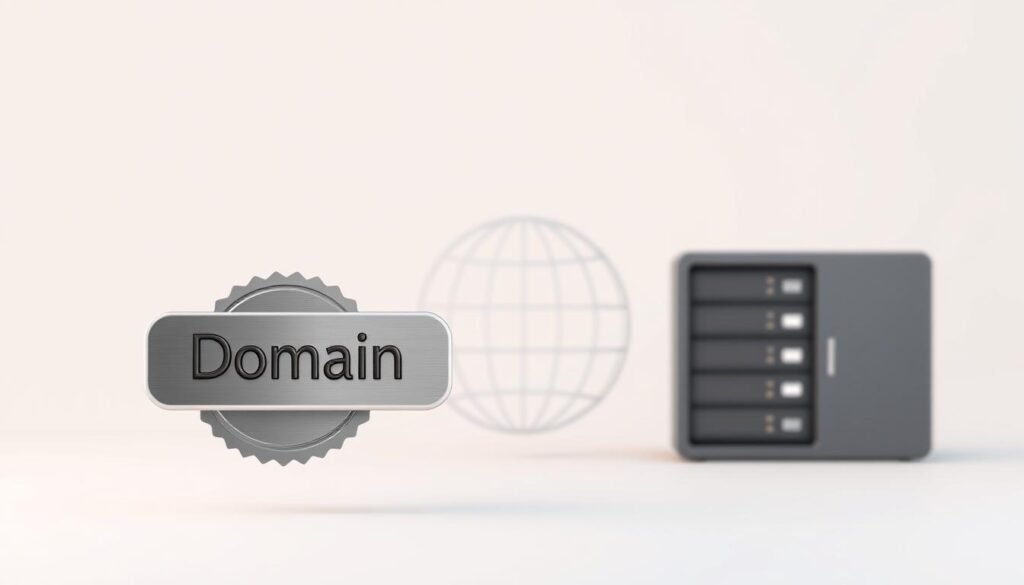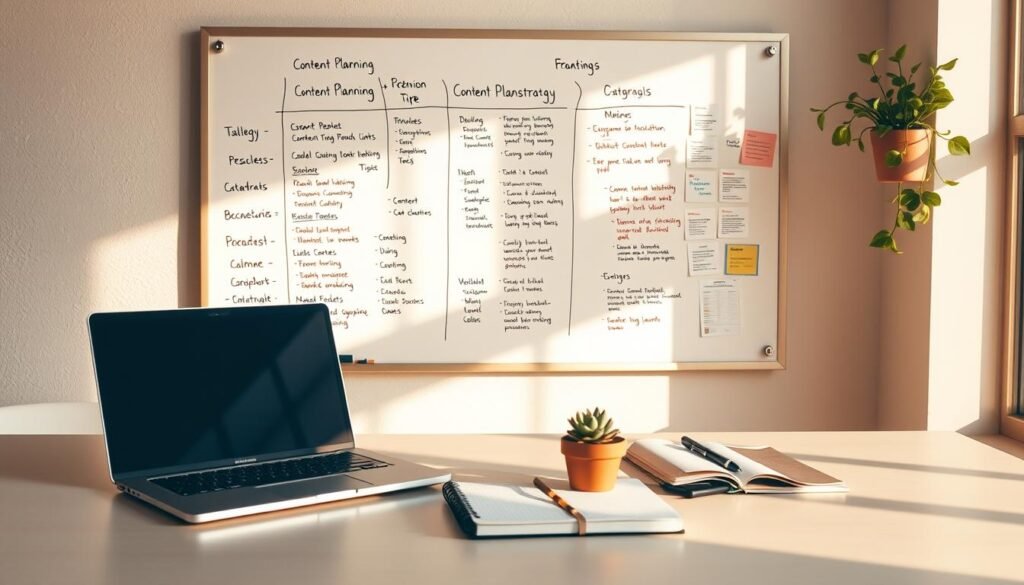Did you know that there are over 600 million blogs on the internet today? With such a vast number of online journals, it’s clear that blogging has become a popular way to share knowledge and connect with others. According to Scott Chow, starting a blog can seem daunting, but it’s an excellent way to express your passion and share your expertise with the world.
For those new to the world of online content creation, blogging offers a unique opportunity to build a community and establish yourself as an authority in your niche. By creating a blog, you can share your ideas, showcase your creativity, and connect with like-minded individuals.
Key Takeaways
- Blogging is a great way to share your knowledge and passion with the world.
- Starting a blog can seem overwhelming, but it’s a straightforward process.
- A blog allows you to build a community and establish yourself as an authority.
- You can share your ideas, showcase your creativity, and connect with others.
- Blogging is an excellent way to express yourself and build your personal brand.
Understanding the Blogging Landscape
To start blogging effectively, it’s crucial to understand the basics of this dynamic and expressive medium. Blogging has become a popular way for individuals and businesses to share their ideas, products, and services with a wider audience.
What is Blogging?
Blogging is essentially creating and publishing content on the internet through a blog. As described by Scott Chow, a blog is a type of website that focuses mainly on written content, known as blog posts. Blogs can be about any topic and are often written in a personal perspective. This personal touch is what makes blogs relatable and engaging to readers.
Blogs serve various purposes, from personal diaries to professional platforms for businesses. They can be used to share knowledge, experiences, or simply to express oneself. The flexibility and accessibility of blogging have made it a favorite among those looking to connect with others online.
Different Types of Blogs
Blogs come in various forms, catering to different interests and needs. Some of the most common types include:
- Lifestyle blogs, which cover everyday life, hobbies, and personal interests.
- Niche blogs, focusing on specific topics such as fashion, travel, or technology.
- Business blogs, used by companies to share industry insights, products, and services.
- Professional blogs, where experts share their knowledge and experiences in their field.
Understanding these different types can help new bloggers decide on the direction they want to take their blog. Choosing the right niche is crucial for attracting and retaining the target audience.
| Type of Blog | Description | Target Audience |
|---|---|---|
| Lifestyle | Covers personal life, hobbies, and interests. | General readers looking for lifestyle tips. |
| Niche | Focuses on specific topics like fashion or technology. | Readers with specific interests. |
| Business | Used by companies to share industry insights and products. | Potential customers and industry professionals. |
By understanding the blogging landscape and the various types of blogs, new bloggers can make informed decisions about their blogging journey. Whether you’re looking to share your passion, promote your business, or simply connect with like-minded individuals, there’s a place for you in the blogging world.
Choosing Your Blog Niche
When it comes to starting a blog, one of the most important decisions you’ll make is choosing your niche. This decision will influence the content you create, the audience you attract, and ultimately, the success of your blog.
Selecting a niche that you’re passionate about is crucial. As Paige Brunton suggests, bloggers should pick a topic they’re enthusiastic about, as it makes the blogging process more enjoyable and sustainable. When you’re passionate about your niche, you’re more likely to produce high-quality content that resonates with your audience.
How to Find Your Passion
To find your passion, start by brainstorming topics that interest you. Ask yourself:
- What hobbies do I enjoy?
- What subjects do I find most fascinating?
- What problems do I want to help solve?
By answering these questions, you can identify potential niches that align with your interests and expertise. For instance, if you’re an avid traveler, you might consider starting a travel blog, sharing your experiences and tips with others.

Researching Market Demand
While passion is a critical factor, it’s equally important to choose a niche with market demand. To do this, you’ll need to research your target audience and understand what they’re looking for. You can use tools like Google Trends, keyword research software, and social media to gauge interest in your chosen niche.
For example, if you’re interested in health and wellness, you can use Google Trends to see how popular this topic is and what specific areas within it are gaining traction. This research will help you refine your niche and create content that meets the needs of your audience.
By combining your passion with market demand, you can create a successful blog that attracts and engages your target audience. Remember, how to start a blog is a common question, and choosing the right niche is a vital step in the process.
Selecting a Blogging Platform
As a beginner, picking the right blogging platform is essential for your blog’s success. With so many options available, it’s crucial to understand the features and benefits of each to make an informed decision.
Popular Blogging Platforms Overview
Several blogging platforms have gained popularity among bloggers, each with its unique features. According to Paige Brunton, popular choices include Squarespace and WordPress, known for their versatility and user-friendly interfaces.
Squarespace is renowned for its sleek designs and ease of use, making it an attractive option for those who prioritize aesthetics. On the other hand, WordPress offers a high degree of customization, appealing to bloggers who seek flexibility and control over their site.
Pros and Cons of Each Platform
When choosing a blogging platform, it’s vital to weigh the pros and cons. Here’s a brief overview:
- Squarespace: Known for its beautiful templates and user-friendly interface. However, it offers limited customization options compared to other platforms.
- WordPress: Offers extensive customization possibilities and a vast array of plugins. Nonetheless, it requires a bit more technical knowledge to fully leverage its capabilities.
As “The right platform can make all the difference in your blogging journey,” says a seasoned blogger. It’s about finding a balance between ease of use, customization, and your specific blogging needs.
Ultimately, the choice of blogging platform depends on your goals, technical comfort, and the type of content you plan to create. By considering these factors and understanding the strengths and weaknesses of each platform, you can make an informed decision that supports your blogging aspirations.
Domain Name and Hosting Basics
Your blog’s identity and accessibility depend on choosing the right domain name and hosting. These two elements are fundamental to establishing a professional online presence.
How to Choose a Domain Name
Selecting a domain name is a critical step in creating your blog. It should be descriptive, easy to remember, and relevant to your content. Scott Chow recommends choosing a descriptive domain name that represents your blog’s brand effectively.
When choosing a domain name, consider the following:
- Keep it short and simple
- Avoid numbers and hyphens if possible
- Ensure it’s easy to spell and pronounce
- Check for availability across social media platforms
Best Hosting Services for Beginners
Once you have your domain name, you’ll need a reliable hosting service. BlueHost is a popular choice among beginners due to its user-friendly interface and affordable plans.
Here’s a comparison of some top hosting services:
| Hosting Service | Price | Storage | Support |
|---|---|---|---|
| BlueHost | $2.95/month | 50 GB SSD | 24/7 Support |
| SiteGround | $3.95/month | 10 GB SSD | 24/7 Support |
| HostGator | $2.75/month | Unlimited | 24/7 Support |
When selecting a hosting service, consider factors such as pricing, storage space, and customer support. It’s essential to choose a service that meets your needs and budget.

Designing Your Blog
For beginners blogging, one of the most critical aspects to consider is the design of your blog. A well-designed blog not only attracts readers but also enhances their overall experience, making them more likely to return.
User Experience Matters
Paige Brunton emphasizes the importance of having a user-friendly design for the blog, making it easier for readers to navigate. A user-friendly design is crucial because it directly impacts how visitors interact with your site. A cluttered or confusing layout can drive potential readers away.
“A clean and intuitive design helps to establish your brand’s credibility and makes your content more accessible.”
To achieve a user-friendly design, consider the following tips:
- Choose a clean and simple theme that aligns with your blog’s niche.
- Ensure your blog is mobile-friendly, as a significant portion of readers will access your site through their smartphones.
- Use clear and concise headings to help readers navigate your content.
- Optimize your images to reduce load times without compromising quality.
Basic Design Tips for Beginners
When it comes to designing your blog, there are several key elements to consider. Here are some basic design tips to get you started:
| Design Element | Description | Best Practice |
|---|---|---|
| Color Scheme | Select colors that reflect your brand and are easy on the eyes. | Stick to 2-3 main colors to maintain consistency. |
| Typography | Choose fonts that are readable and consistent across your blog. | Use no more than 2-3 font styles to avoid visual clutter. |
| Layout | Organize your content in a logical and visually appealing manner. | Use white space effectively to enhance readability. |
By focusing on these design elements, you can create a blog that is both visually appealing and easy to navigate, providing a better experience for your readers.
As you start a blog, remember that your design should evolve with your content and audience. Continuously gather feedback and be willing to make adjustments to improve your blog’s overall design and user experience.
Content Planning and Strategy
Effective content planning is the backbone of a successful blog, enabling new bloggers to establish a strong online presence. A well-thought-out content strategy helps in maintaining consistency, engaging the target audience, and ultimately driving the blog’s success.
As Paige Brunton suggests, using an editorial calendar to plan content in advance is a great way to ensure organization and consistency. This approach allows bloggers to visualize their content pipeline, making it easier to manage and adjust their strategy as needed.
Creating a Content Calendar
A content calendar is a crucial tool for bloggers, helping them plan and schedule content in advance. It ensures that the blog remains active and that content is consistently delivered to the audience.
- Plan your content around key dates and events relevant to your niche.
- Use a mix of evergreen and timely content to keep your audience engaged.
- Schedule regular posts to maintain consistency and keep your audience coming back.

Types of Content to Consider
Diversifying your content is key to keeping your audience engaged. Consider incorporating various types of content into your strategy, such as:
| Content Type | Description | Benefits |
|---|---|---|
| How-to Guides | Step-by-step instructions on a particular topic. | Establishes authority, educates the audience. |
| Listicles | Content presented in a list format. | Easy to consume, shareable. |
| Personal Stories | Sharing personal experiences or anecdotes. | Creates a connection with the audience, relatable. |
By incorporating these content types and maintaining a consistent schedule through a content calendar, new bloggers can develop a robust content strategy that attracts and retains a loyal audience.
Writing Engaging Blog Posts
Engaging blog posts are the backbone of any successful blogging strategy, as they attract readers and keep them coming back. To create a blog that resonates with your audience, you need to focus on crafting posts that are both informative and captivating.
Tips for Captivating Headlines
Your headline is the first thing that readers see, and it plays a crucial role in determining whether they will click on your post or not. Here are some tips for crafting captivating headlines:
- Use action verbs and questions to pique the reader’s curiosity.
- Keep it concise and to the point, avoiding unnecessary words.
- Use numbers and statistics to make your headline more compelling.
- Ensure that your headline accurately reflects the content of your post.
Crafting Quality Content
Crafting quality content is essential for how to start a blog that attracts and retains readers. Here are some strategies to enhance your content:
Understanding your audience is key to creating content that resonates with them. You need to know their interests, needs, and pain points to tailor your content accordingly.
| Content Strategy | Description | Benefits |
|---|---|---|
| Know Your Audience | Understand their interests and needs. | Increased engagement and relevance. |
| Use Storytelling | Share personal anecdotes and examples. | Emotional connection with readers. |
| Optimize for SEO | Use keywords strategically. | Improved visibility in search results. |
By implementing these strategies, you can significantly improve the quality of your blog posts and attract a loyal readership. Remember, the goal is to create a blog that provides value to your readers, thereby establishing your authority in your niche.
SEO Fundamentals for New Bloggers
As a new blogger, understanding SEO fundamentals is crucial for increasing your blog’s visibility. Search Engine Optimization (SEO) is a vital tool that helps ensure your content reaches the right audience. Paige Brunton emphasizes the importance of SEO for bloggers, suggesting that it can significantly impact the blog’s visibility in search results.
Why SEO Matters
SEO is essential for bloggers because it helps search engines like Google understand and rank your content. When done correctly, SEO can drive more traffic to your blog, increasing your chances of attracting and retaining a loyal audience. Effective SEO strategies can make a significant difference in your blog’s success.
One of the primary reasons SEO is important is that it helps you target specific keywords that your audience is searching for. By optimizing your content around these keywords, you can improve your blog’s ranking on search engine results pages (SERPs).
Basic SEO Techniques to Implement
Implementing basic SEO techniques can significantly improve your blog’s visibility. Here are some fundamental strategies to get you started:
- Keyword Research: Identify relevant keywords that your target audience is searching for.
- Optimize Your Titles and Meta Descriptions: Craft compelling titles and meta descriptions that include your target keywords.
- Use Header Tags: Organize your content with header tags (H1, H2, H3, etc.) to improve readability and structure.
- Internal and External Linking: Link to other relevant content on your blog and to external sources to enhance credibility.
- Image Optimization: Use descriptive alt tags and file names that include your target keywords for images.

By implementing these basic SEO techniques, new bloggers can improve their blog’s visibility and attract more readers. Remember, SEO is an ongoing process that requires continuous learning and adaptation to the latest best practices.
Promoting Your Blog
Promoting your blog effectively is key to reaching a wider audience and building a loyal following. With numerous strategies available, focusing on the right methods can make a significant difference in your blog’s success.
Social Media Promotion Strategies
Social media platforms are powerful tools for promoting your blog. According to Paige Brunton, leveraging social media can significantly enhance your blog’s visibility. To get started:
- Identify the platforms where your target audience is most active.
- Create engaging content that encourages sharing and interaction.
- Use relevant hashtags to increase the discoverability of your posts.
- Engage with your followers by responding to comments and messages promptly.
Building an Email List
Building an email list is another effective way to promote your blog and stay in touch with your readers. Here are some steps to consider:
- Create a compelling opt-in incentive, such as a free e-book or exclusive content, to encourage visitors to subscribe.
- Place visible and enticing sign-up forms on your blog to capture email addresses.
- Send regular newsletters that include updates, tips, and links to your latest blog posts.
- Personalize your emails to foster a connection with your subscribers.
By implementing these strategies, you can effectively promote your blog and grow your audience. Consistency and engagement are key to maintaining a strong connection with your readers.
Monetizing Your Blog
With the right approach, bloggers can transform their blogs into lucrative online businesses. As Scott Chow mentions, bloggers can make money through various methods, including affiliate marketing and sponsored content.

Monetizing a blog involves exploring different strategies to generate income. For new bloggers, understanding these methods is crucial for turning their passion into a profitable venture.
Affiliate Marketing for Beginners
Affiliate marketing is a popular method for bloggers to earn money by promoting products or services and earning a commission for each sale made through their unique referral link.
To get started with affiliate marketing, bloggers should:
- Choose a niche that aligns with their blog’s content
- Research affiliate programs such as Amazon Associates or ShareASale
- Create valuable content that promotes products naturally
As noted by experts, “Affiliate marketing is a great way to monetize a blog because it allows bloggers to promote products they believe in and earn money from their recommendations.”
Different Ways to Make Money Blogging
Besides affiliate marketing, there are several other ways to monetize a blog, including:
- Display advertising through Google AdSense
- Sponsored content and product reviews
- Selling digital products or services
- Membership or subscription-based models
Display advertising can be an effective way to earn money, especially for blogs with high traffic. However, it’s essential to balance ads with user experience to avoid overwhelming readers.
For bloggers looking to start a blog and eventually monetize it, understanding these strategies from the outset is vital. By incorporating blogging basics and focusing on quality content, bloggers can set themselves up for success in the world of online publishing.
Staying Consistent and Motivated
As a beginner blogger, staying consistent and motivated is crucial for your blog’s success. The journey to building a successful blog can be long and challenging, but with the right mindset and strategies, you can maintain your momentum.
Building a Blogging Routine
Establishing a routine is vital for consistency. Here are some tips to help you build a blogging routine:
- Set Realistic Goals: Start by setting achievable goals, such as posting once a week. As you become more comfortable, you can increase the frequency.
- Create a Content Calendar: Plan your content in advance using a calendar. This helps in organizing your thoughts and ensuring that you have a consistent flow of posts.
- Stick to a Schedule: Decide on a schedule that works for you and stick to it. Consistency is key to keeping your audience engaged.
Overcoming Common Blogging Challenges
Bloggers often face several challenges, from writer’s block to maintaining audience engagement. Here are some strategies to overcome these challenges:
| Challenge | Strategy to Overcome |
|---|---|
| Writer’s Block | Take a break, change your environment, or brainstorm ideas with others. |
| Low Engagement | Engage with your audience on social media, ask for feedback, and create content that resonates with them. |
| Technical Issues | Regularly update your blogging platform, use reliable hosting services, and have a backup plan. |
By implementing these strategies, you can overcome common blogging challenges and maintain your motivation. Remember, the key to success in blogging is consistency and the willingness to adapt and learn.
For more insights on how to start a blog and maintain it successfully, consider exploring additional resources and communities that support beginner bloggers.
Analyzing Your Blog’s Performance
As you create a blog and implement various blogging tips for beginners, tracking its performance is crucial to understanding what works and what doesn’t. Analyzing your blog’s performance helps you refine your content and marketing strategies to better engage your audience.
Tracking Traffic and Engagement
To analyze your blog’s performance, you need to track traffic and engagement metrics. Tools like Google Analytics provide insights into page views, bounce rates, and average session duration. Scott Chow recommends using these analytics tools to track your blog’s performance and adjust your strategy accordingly.
Adjusting Your Strategy
Once you have data on your blog’s performance, you can adjust your strategy to improve results. For instance, if you notice a high bounce rate, you may need to revisit your content or design to make it more user-friendly. By regularly analyzing your blog’s performance and making data-driven decisions, you can continually improve your blogging efforts and attract more readers.
FAQ
What is the best way to start a blog for beginners?
How do I choose a profitable niche for my blog?
What are the most popular blogging platforms for beginners?
How important is SEO for a new blog?
Can I monetize my blog right away?
How often should I post on my blog?
What are some effective ways to promote my blog?
How do I track my blog’s performance?
What are some common challenges faced by beginner bloggers?
How can I stay motivated as a blogger?
Prabir Dutta
Prabir Dutta is a passionate digital creator, affiliate marketer, and wellness enthusiast who simplifies complex topics like AI tools, Vastu, pet care, and modern living. With a keen eye for SEO, tech trends, and everyday health solutions, he writes to empower readers with actionable, smart-living insights. When not curating content across his network of niche blogs, Prabir enjoys exploring new digital tools that make life easier and more efficient.






